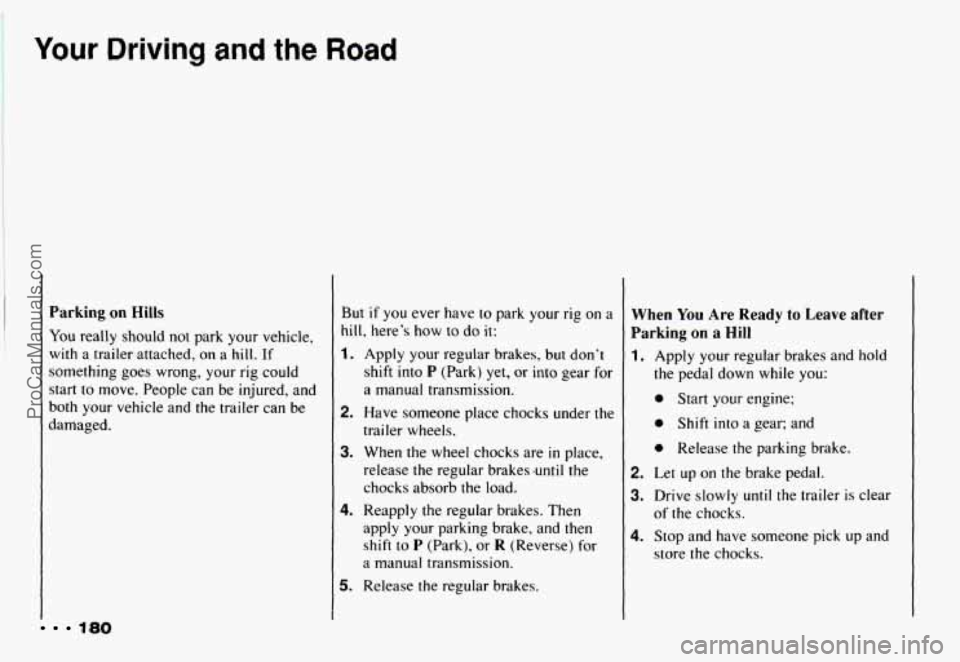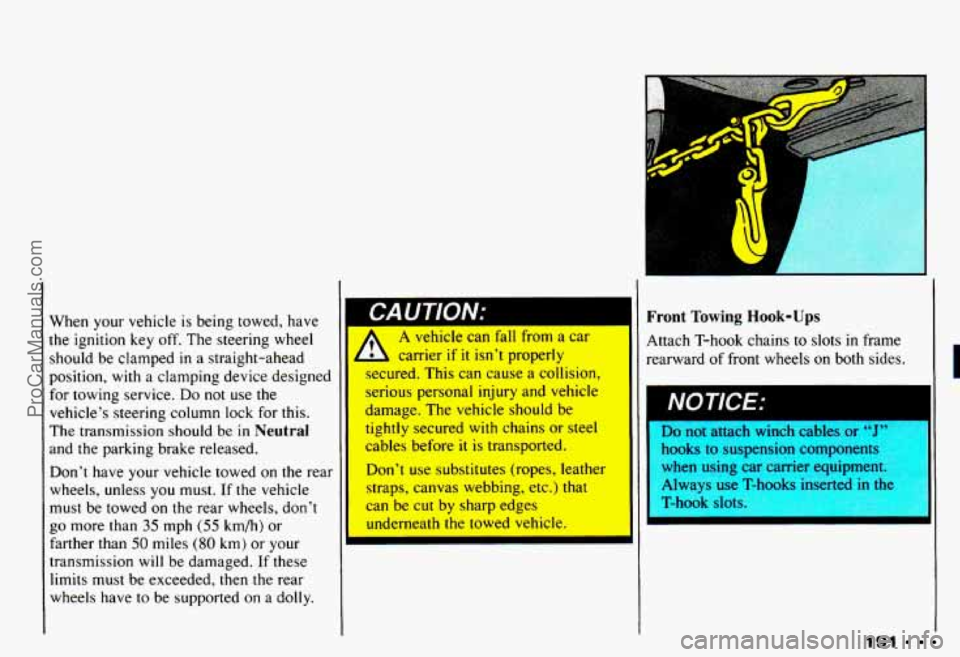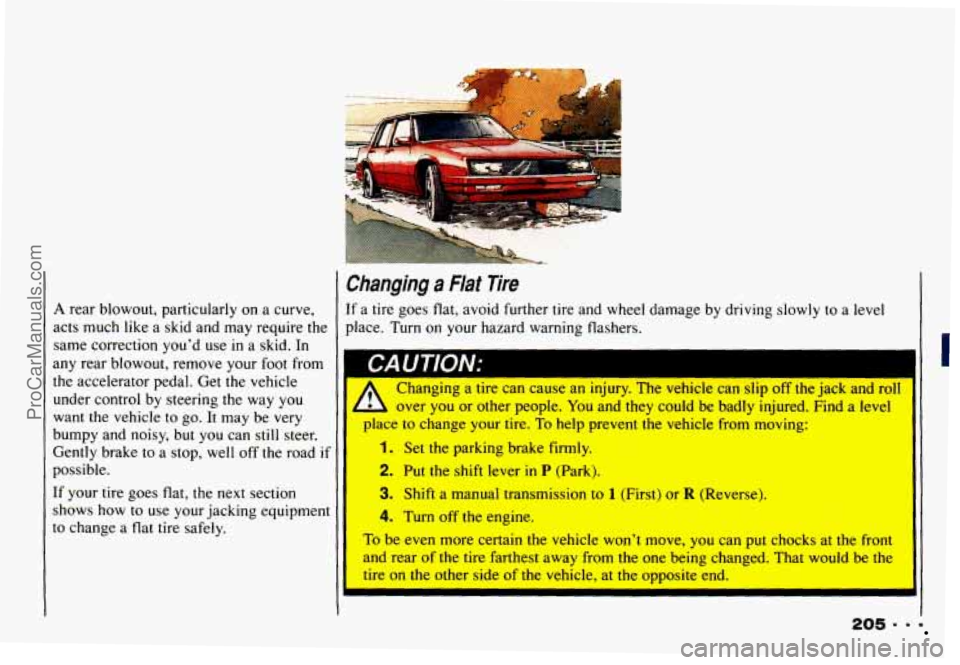Page 183 of 358

Turn Signals When Towing a Trailer
When you tow a trailer, your vehicle has to
have a different turn signal flasher and
extra wiring. The green arrows on your
instrument panel will flash whenever you
signal a turn or lane change. Properly
hooked up, the trailer lights will also flash,
telling other drivers you’re about to
turn,
change lanes or stop.
When towing a trailer, the green arrows on
your instrument panel will flash for turns
even if the bulbs on the trailer are burned
out. Thus,
you may think drivers behind
you are seeing your signal when they are
not. It’s important to check occasionally to
be sure the trailer bulbs are still working.
Driving on Grades
Reduce speed and shift to a lower gear
before you start down a long or steep
downgrade. If
you don’t shift down, you
might have to use your brakes
so much
that they would get hot and no longer work well.
On a long uphill grade, shift down and
reduce your speed to around
45 mph
(70 km/h) to reduce the possibility of
engine and transmission overheating. If you
are towing a trailer and you
have an automatic transmission with
Overdrive, you may prefer to drive
in D
instead of Overdrive (or, as you need to,
a lower gear). Or, if you have a manual
transmission
with fifth (or sixth) gear
and you are towing a trailer, it’s better
not to use
fifth (or sixth) gear. Just drive
in fourth gear (fifth gear
if you have
a six-speed manual transmission)
(or, as you need to, a lower gear.
ProCarManuals.com
Page 184 of 358

Your Driving and the Road
I
180
Parking on Hills
You really should not park your vehicle,
with a trailer attached, on a hill. If
something goes wrong, your rig could
start to move. People can be injured, and
both your vehicle and the trailer can be
damaged.
But if you ever have to park your rig on a
hill, here's how to do it:
1. Apply your regular brakes, but don't
shift into
P (Park) yet, or into gear for
a manual transmission.
2. Have someone place chocks under the
trailer wheels.
3. When the wheel chocks are in place,
release the regular brakes-until the
chocks absorb the load.
4. Reapply the regular brakes. Then
apply your parking brake, and then shift to
P (Park), or R (Reverse) for
a manual transmission.
5. Release the regular brakes.
When You Are Ready to Leave after
Parking on
a Hill
1. Apply your regular brakes and hold
the pedal down while you:
0 Start your engine;
0 Shift into a gear; and
0 Release the parking brake.
2. Let up on the brake pedal.
3. Drive slowly until the trailer is clear
4. Stop and have someone pick up and
of the chocks.
store the chocks.
ProCarManuals.com
Page 185 of 358
Maintenance When Trailer Towing
Your vehicle will need service more often
when you're pulling a trailer. See the
Maintenance Schedule for more on this.
Things that are especially important
in
trailer operation are automatic
transmission
fluid (don't overfill), engine
oil, axle lubricant. belts. cooling system,
and brake adjustment. Each of these is
covered
in this manual, and the Index will
help you find them quickly. If you're
trailering, it's
a good idea to review these
sections before
you start your trip.
Check periodically to see that all hitch
nuts
and bolts are tight.
ProCarManuals.com
Page 195 of 358

When your vehicle is being towed, have
the ignition
key off. The steering wheel
should be clamped
in a straight-ahead
position,
with a clamping device designed
for towing service.
Do not use the
vehicle’s steering column lock for this.
The transmission should be in Neutral
and the parking brake released.
Don’t have your vehicle towed on the rear
wheels, unless you must.
If the vehicle
must be towed on the rear wheels, don’t
EO more than 35 mDh (55 kmh) or I
CAUTION:
RA
I Front Towing Hook-Ups
A vehicle can fall from a car
Attach T-hook chains to slots in frame
carrier if
it isn’t properly rearward of front wheels on both sides.
secured. This can cause a collision,
tightly secured with chains or steel
cables before
it is transported.
Don’t
use substitutes (ropes, leather
straps, canvas webbing, etc.) that
can be cut by sharp edges
underneath the towed vehicle.
Farther than
50 miles (80 km j or your
transmission
will be damaged. If these
limits must be exceeded, then
the rear
wheels have to be supported on
a dolly.
I.
I
Do not attach winch cables or
1 hooks to suspension components
en using car carrier equipment
I Always use T-hooks inserted in the
I I
I T-hook slots. II
191 ProCarManuals.com
Page 208 of 358
Problems on the Road
I lh
1
F. $. '
9. Shut the engine off and replace the
pressure cap. Be sure the arrows
on
the cap line up like this.
Y CI.
10. Then fill the coolant recovery tank
For a complete drain. flush and refill, see
your Chevrolet dealer or a Chevrolet
Carnaro Service
Manual. To purchase
a service manual, see "Service
Publications"
in the Index.
to the proper level.
If a Tire Goes Flat
It's unusual for
a tire to "blow out" while
you're driving, especially
if you maintain
your tires properly.
If air goes out of a
tire, it's much more likely
to leak out
slowly.
But if you should ever have a
"blowout," here are a few tips about what
to expect and what to do:
If a front tire fails, the flat tire will create
a drag that pulls the vehicle toward that
side. Take your foot off the accelerator
pedal and grip the steering wheel firmly.
Steer
to maintain lane position, then
gently brake to a stop well out of
the
traffic lane.
ProCarManuals.com
Page 209 of 358

I Changing a Flat lire
’ A rear blowout, particularly on a curve, If a tire goes flat, avoid further tire and wheel damage by driving slowly to a level
acts much like a skid and may require the place. Turn on your hazard warning flashers.
If your tire goes flat, the next section
shows how to use your jacking equipment
to change a flat tire safely.
1 CAUTION:
same correction you’d use in-a skid. In I -
any rear blowout, remove your foot from
the accelerator pedal. Get the vehicle
under control by steering
the way you
want
the vehicle to go. It may be very
bumpy and noisy, but you can still steer.
Gently brake to a stop, well off the road
if
possible. (I
A Changing a tire can cause an injury. The vehicle can slip off the jack and roll
over you or other people. You and
they could be badly injured. Find a level
I place to ccange your tire. To help prevent the vehicle from moving:
1. Set the parking brake firmly.
2. Put the shift lever in P (Park).
3. Shift a manual transmission to 1 (First) or R (Reverse). I
4. Turn off the engine.
To be even more certain the vehicle won’t move, you can put chocks at the front
and rear of the tire farthest away from the one being changed. That would be
tht
tire on the other side of the vehicle, at the opposite end.
L
I
205 - =
I
ProCarManuals.com
Page 221 of 358

Part b
Here you will find information
about the care
of your Chevrolet .
This part begins with service and
fuel information. and then it shows
how
to check important fluid and
lubricant levels
. There is also
technical information about your
vehicle. and a section devoted to
its appearance care
.
Service & Appearance Care
Service .......................................................... 218
Fuel
............................................................ 219
Checking Things under the Hood
..................................... 223
HoodRelease
................................................... 223
Engineoil
...................................................... 226
Aircleaner
..................................................... 230
Automatic Transmission Fluid
...................................... 233
Manual Transmission Fluid
........................................ 235
Hydraulicclutch
................................................ 237
RearAxle
...................................................... 237
Enginecoolant
.................................................. 238
Power Steering Fluid
............................................. 242
Windshield Washer Fluid
.......................................... 243
Brake Master Cylinder
............................................ 244
Battery
........................................................ 246
Bulb Replacement
................................................. 247
Loading Your Vehicle
.............................................. 255
Appearance Care and Maintenance Materials
............................ 274
Vehicle Identification Number (VIN)
.................................. 275
Service Parts Identification Label
..................................... 275
Add-on Electrical Equipment
........................................ 275
Fuses and Circuit Breakers
.......................................... 276
Replacement Bulbs
................................................ 279
Capacities and Specifications
......................................... 280
Tires
............................................................ 256
Appearancecare
.................................................. 265
217
ProCarManuals.com
Page 228 of 358
Service 8t Appearance Care
c
Then go to the front of the vehicle and
pull up on the hood release.
Lift
the hood.
I
I CAUTION:
An electric fan under the hood
can start up and injure you
even when
the engine is not
running. Keep hands, clothing and
tools away from any underhood
* xtric fan.
I
Y
3.4L L32 (Code S)
When you open the hood you'll see.
1. Battery
2. Engine Coolant Reservoir
3. Engine Oil Dipstick
4. Automatic Transmission Dipstick
5. Air Cleaner
(if equipped)
6. Oil Fill Cap
7. Brake Fluid Reservoir
8. Power Steering Reservoir
9. Windshield Washer Reservoir
10. Engine Fan
11. Clutch Fluid Reservoir (if equipped)
224
ProCarManuals.com